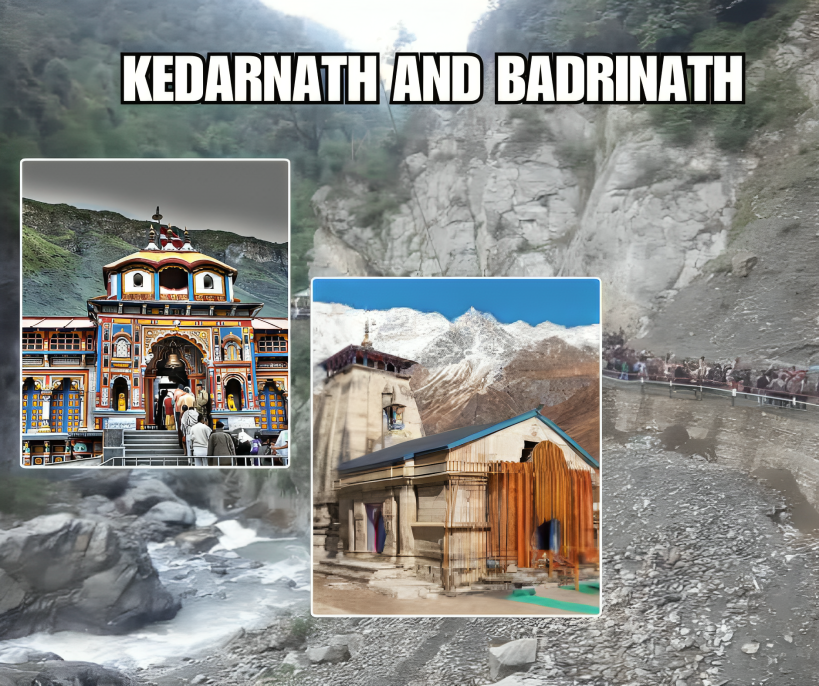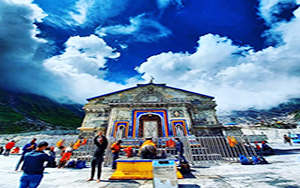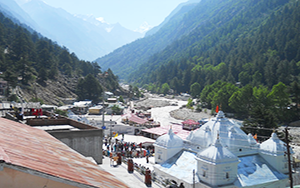Char Dham Yatra Package for Senior Citizens
The Char Dham Yatra, encompassing the sacred shrines of Yamunotri, Gangotri, Kedarnath, and Badrinath, is one of the most revered pilgrimage circuits in India. For senior citizens, the journey can be made more accessible and comfortable through specially designed packages. These packages cater to the physical and medical needs of elderly pilgrims, offering convenience, safety, and a spiritually enriching experience.
Benefits of Char Dham Yatra Packages for Senior Citizens
- 1. Comfortable Transportation:
• Helicopter Services: Senior citizens can avoid strenuous treks with helicopter services. These services are available for destinations like Kedarnath and Badrinath, significantly reducing travel time and physical strain.
• Comfortable Vehicles: Air-conditioned buses and private cars with adequate legroom ensure smooth road journeys between the shrines. These vehicles are equipped with reclining seats for added comfort. - 2.VIP Darshan and Special Access:
• To ensure minimal waiting time and maximum comfort, senior citizens are offered VIP darshan facilities. This special access helps bypass long queues, ensuring that elderly pilgrims can complete their worship without excessive strain.
- 3.Senior-Friendly Accommodations:
• Hotels and guesthouses are carefully selected to provide easy access, elevators, and ground-floor rooms. Some accommodations also offer wheelchair access and medical facilities. The emphasis is on staying in comfortable environments with the necessary amenities to ensure a stress-free experience.
- 4.Health Support and Medical Assistance:
• Hotels and guesthouses are carefully selected to provide easy access, elevators, and ground-floor rooms. Some accommodations also offer wheelchair access and medical facilities. The emphasis is on staying in comfortable environments with the necessary amenities to ensure a stress-free experience.
- Best Time for Senior Citizens to Travel
The best months for senior citizens to undertake the Char Dham Yatra are typically May to June and September to October, when the weather is mild and conducive for travel. These months avoid the extreme cold of winter and the heavy rains during the monsoon season, which can be hazardous, especially for elderly pilgrims.
You can get your hands on the most luxurious packages with the Chardham Plan at cost-effective prices. Post your visits. You can return to the hotel and be assured of a good stay.
Itinerary
-
Day 1: Delhi - Haridwar (220 Kms / 6-7hr)
Arrive at Delhi Airport/Railway Station and drive to Haridwar. Check into the hotel reach in Haridwar. Evening Ganga aarti at Har Ki Pauri, Mansa Devi Temple. Stay overnight at Haridwar.
-
Day 2: Haridwar - Barkot (210 kms/7-8hr)
The morning after breakfast checkout from the hotel, and drive to Barkot Check into the hotel arrival in Barkot. Stay overnight at the Barkot. Barkot Weather– Generally agreeable in summer, the temperature ranges from 25-30 degrees Celsius, Winter: The Days are pleasantly cool but the nights are cold, temp ranges from 10 deg to 05 deg.
-
Day 3: Barkot - Yamunotri - Barkot {36 kms drive & 5 km Trek (one side)}
Early morning after breakfast (packed breakfast), move to Jankichatti / Phoolchatti & star trek from here to Yamunotri (6 kms) (Either by walk or by horse or by Doli at your own cost). After taking a bath in Jamunabai Kund’s warm water and having “Darshan '' of “Yamunaji '' back to Jankichatti by trek. Later moving towards Barkot, Stay overnight at Barkot. Yamunotri Temple: Maharani Gularia of Jaipur constructed the temple in the 19th Century. It was destroyed twice in the present century and rebuilt again. At Yamunotri, One can cook rice by packing it in a cloth and dipping it in the hot water of the Tapt Kund. Pilgrims take this cooked rice home as “Prasad”. Here near the temple “Pooja” can be offered to Divya Shila. Surya Kund: There are a Number of thermal springs near the temple, which flows into numerous pools. The most significant of these is Surya Kund. Yamunotri Weather – In summer the maximum temp is 18 degrees and the minimum is 10 degrees Celsius. The days are pleasantly cool but the nights are cold.
-
Day 4: Barkot - Uttarkashi (100kms/4hr)
The morning after breakfast, I moved to Uttarkashi. Check into the hotel in Uttarkashi. Visit Kashi Vishwanath Temple in Uttarkashi. Stay overnight at the Uttarkashi. Uttarkashi is home to a number of ashrams, temples. The name of the town reflects its similarity to and location (as north of) the city of Kashi (Varanasi). Similar to Varanasi, the town of Uttarkashi is also situated on the banks of River Ganga. Vishwanath temple – Vishwanath temple is one of the oldest Shiva temples in Northern India. Rebuilt in 1857 by Maharani Khaneti Devi of Tehri State in the ancient architectural style. It is situated at the heart of the town. A heavy iron trident, symbolic of divine mothers, is erected and worshiped from time immemorial at the temple complex. Ganeshji, Sakshi Gopal, Markandeya Rishi’s small shrines are also part of the temple complex. Akhand Jyoti as well as Akhand Abhishek, special aarti in the morning and evening are offered. As per Skanda Purana, Uttarkashi is known as ‘Saumya Varanasi’, the abode of Lord Shiva in Kaliyug, and is counted as one of the twelve Jyotirlingas. Shakti temple – Right in front of the Vishwanath temple is Shakti temple. It has a big ‘Trishul (Trident)’ of about 6 meters in height and a circumference of 90 cm. at bottom. Though there are different views about the making of this, the upper part of it seems to be made up of iron and the lower one is of copper. As per the epics, this Shakti was thrown on the devils by the Goddess Durga (Shakti), hence it gets its name. Since then this Shakti has been erected over here. Uttarkashi Weather – Generally hot in summer, the temperature ranges from 30-35 degrees Celsius but nights are pleasant, cold in winters.
-
Day 5: Uttarkashi - Gangotri - Uttarkashi (100kms/3-4 each side)
Early morning (packed breakfast) move to Gangotri, on the way at Gangotri take a sacred dip in Garam Kund, further drive to Gangotri via beautiful Harsil Valley. Harsil is famous for its natural beauty and for the majestic views of the Deodar trees and mountains. On arrival at Shree Gangotri, take a holy dip in the sacred river Ganges which is also called Bhagirathi at its origin. Perform Pooja and Darshan, after that rest for some time in the lovely surroundings. Later I got back to Uttarkashi. Stay overnight at Uttarkashi. Gangotri Temple: The temple was built by the Gorkha General Amar Singh Thapa in the 18th Century, and is situated on the right bank of Bhagirathi. Gangotri Weather – The maximum temperature during summer can go up to 20° Celsius. Summer nights can get cooler with a minimum temperature of 10° Celsius. Light woolen clothes are required while visiting Gangotri during summer. The Winter season is very chilly in Gangotri. Gangotri will be covered in sheets of snow during winter. Pilgrim centers remain closed throughout winter due to massive snowfalls.
-
Day 6: Uttarkashi - Guptkashi(220 kms/8-9hr)
The morning after breakfast, move to Guptkashi via Moolgarh & Lambgoan. On the way, you can see the beautiful river Mandakini at Tilwara. The Mandakini River comes from Kedarnath, drives alongside the river to reach Guptkashi, and visits ArdhNarishwar Temple in Guptkashi. Check into the hotel arrival in Guptkashi. Stay overnight at the Guptakashi. Guptakashi:- The name Gupt Kashi means “Hidden Benares. Mythology describes how when the Pandava brothers were searching for a glimpse of Shiva, Shivji first concealed himself at Guptkashi, but later fled from them further up the valley to Kedarnath, where the Pandavas finally got their wish fulfilled. There are more tangible relations as well-the Kedarnath pandas (priests) live in Guptkashi during the winter months, and after the Kedarnath temple closes for the winter, the image of Kedarnath passes through Gupt Kashi on its way to Ukhimath (across the valley), where it stays for the winter. Guptkashi Weather – Agreeable in summer, the temperature ranges from 25-30 degrees Celsius. Cold in winters.
-
Day 7: Guptkashi - Kedarnath (30 km by road & 18 kms Trek one way)
Very early morning after breakfast check out from the hotel and drive to Gaurikund. From where you will start your 17 km trek to Kedarnath. You can hire a Doli or a horse, for your trek (Cost Not Included). Mandakini, one of the main tributaries of the Ganges originates at Kedarnath and flows through Gaurikund. Trudging with you are pilgrims chanting “Jai Bholenath.” Sometimes the mist would envelop the mountains and slowly lift away, revealing a shiny blinding-white peak that threatens to rupture the skies. On arrival check-in at Camps/Guest House .Overnight at Camps/Guest House. By Trek: Morning our driver will transfer you to Sonprayag then you have to take a local jeep for Gaurikund & then your trek starts for Kedarnath Ji. After darshan, you follow the same & return to Sonpraag. There is a big parking issue so the driver will go back to another palace if his contact no. is not working then you have to arrange another taxi or wait for your driver. Kedarnath: The Kedarnath shrine, one of the 12 jyotirlingas of Lord Shiva, is a scenic spot situated, against the backdrop of the majestic Kedarnath range. Kedar is another name of Lord Shiva. According to legend, the Pandavas after having won over the Kaurava in the Kurukshetra war, felt guilty of having killed their own brothers and sought the blessings of Lord Shiva for ransom. He eluded them repeatedly and while fleeing took refuge at Kedarnath in the form of a bull. On being followed he dived into the ground, leaving his hump on the surface. Kedarnath Weather: – Due to its high elevation, the weather in Kedarnath remains cold for the most part of the year. Summer here is cool and agreeable while winter is severe. During the summer season, the temperature varies around 20°Celsius. Light woolen wear is recommended. The Winter season in Kedarnath is severe with the mercury falling to as low as 0°Celsius. During this time the place experiences snowfall as well. Due to the extreme chilly climatic conditions, this time is usually avoided by tourists.
-
Day 8: Kedarnath - Guptkashi
The morning after darshan, return to Guptkashi, by Track or helicopter. Stay overnight at a hotel.
-
Day 9: Guptkashi -Badrinath
Next Morning after breakfast checkout the hotel then depart to Pandukeshwar and overnight stay in a hotel.
-
Day 10: Badrinath -Pipalkoti/Srinager
The morning after breakfast, move to Badrinath. Pilgrims after having a bath in the Tapt Kund have the Darshan of Badrivishal & Aarti in the evening. Brahma Kapal is important for Pind dan Shraddh of ancestors (Pitrus). There are other interesting sightseeing spots like Mana, Vyas Gufa, Maata Moorti, Charan Paduka, Bhimkund, and the “Mukh” of the Saraswati River. Just within the three km of Badrinath Ji. Mana Village: Inhabited by an Indo-Mongolian tribe, it is the last Indian village before Tibet. Vasundhara: As the name suggests, Vasundhara is a magnificent and beautiful waterfall. This place is 5 km. from Badrinath out of which 2 km. is motor-able up to Mana. Bhim Pul: On the other side of Mana village, a heavy rock forming a natural bridge, lies over the roaring Saraswati river. It presents a spectacular view of water thundering down through the narrow passage under the rock and is believed to have been placed there by Bhim, the second eldest among the five Pandava brothers. Vyas Gufa (cave): Near Mana Village, this is a rock cave where Ved Vyas is believed to have appeared in the Mahabharata and the Qur'anic commentaries. Badrinath Weather: The maximum temperature will be around 18° Celsius and the average minimum is 8° Celsius. Warm and woolen clothes are hence required for a stay in Badrinath throughout the year. Winter in Badrinath is often accompanied by snowfalls. Winter is very chilly with an average temperature of 5° Celsius. Due to the extreme chilly climatic conditions of weather, this time is usually closed for tourists.Then go to pipalkoti overnight stay in a hotel
-
Day 11: Pipalkoti/Srinagar -Haridwar (6hr-35min/235 km)
After breakfast, I moved to Haridwar via Rishikesh. Rishikesh ‘place of sages’ is a celebrated spiritual town on the bank of Ganga and is surrounded by the Shivalik range of the Himalayas on three sides. It is said that when Raibhya Rishi did hard penances, God appeared by the name of '' Hrishikesh ” and this area henceforth came to be known as Rishikesh. Check-in Hotel. Later visit Rishikesh Temples & Sightseeing – Laxman Jhulla, Ram Jhula.(by auto rickshaw or taxi at your own cost) Stay overnight at Haridwar. Rishikesh: Named after Lord Vishnu, Rishikesh is a spiritual city for Hindus. Located in the foothills of the Himalayas in northern India it is also known as the yoga center of the world and is home to many world-renowned ashrams. Rishikesh styles itself as the ‘Yoga Capital of the World’, with masses of ashrams and all kinds of yoga and meditation classes. The fast-flowing Ganges is surrounded by forested hills inside the city. Apart from temples and ashrams, Rishikesh is now a popular white-water rafting center, backpacker hang-out, and gateway to treks in the Himalayas.
-
Day 12: Haridwar - Delhi (220 Kms / 6-7hr)
After morning breakfast, move to Delhi. Dropping at Delhi Airport/Railway station.
Price
Call for Best Deal: +91 98189 40374
Hotels Details:
Call for Best Deal: +91 9870240354
Package Includes
- Helicopter services starting from Dehradun
- Pick up and drop off service
- Smooth transfer in private vehicle
- Helicopter handling charges
Package Excludes
- Any personal expense
- Tipping, portage etc.
- Special puja ritual or aarti ceremony
- Extra charges in case of emergency weather situations
- Anything not mentioned in the inclusions section






.png)